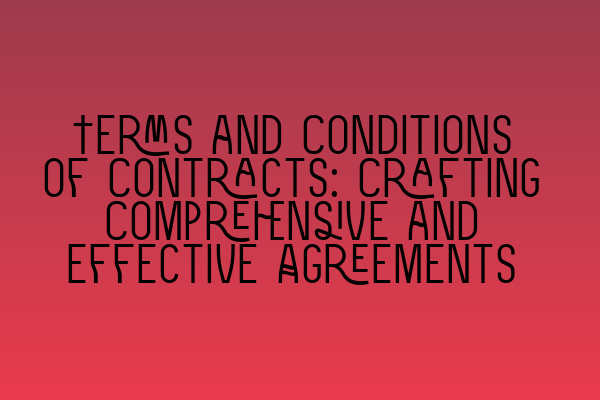Terms and Conditions of Contracts: Crafting Comprehensive and Effective Agreements
When it comes to entering into a contract, whether it’s a business-to-business transaction or a consumer purchase, having well-drafted and comprehensive terms and conditions is crucial. These terms and conditions outline the rights and responsibilities of each party involved and help prevent potential disputes or misunderstandings down the line. In this article, we will discuss the importance of crafting comprehensive and effective terms and conditions for contracts, as well as provide some tips for doing so.
1. Understand the Purpose and Scope of Your Contract:
Before you start drafting your terms and conditions, it’s important to have a clear understanding of the purpose and scope of your contract. This will help you tailor your terms and conditions to the specific needs and requirements of the agreement. Whether it’s a sale of goods, provision of services, or a licensing agreement, make sure you have a well-defined objective in mind.
2. Include Essential Elements in Your Terms and Conditions:
Your terms and conditions should include certain essential elements to ensure clarity and enforceability. These elements may include:
– Identification of the parties involved: Clearly specify the names and contact details of the parties entering into the contract.
– Offer and acceptance: Clearly state the offer made by one party and the acceptance of that offer by the other party.
– Consideration: Outline the consideration or value exchanged between the parties, such as payment or services rendered.
– Duration and termination: Specify the duration of the contract and the circumstances under which it can be terminated by either party.
– Governing law and jurisdiction: Clearly state which laws will govern the contract and which jurisdiction will have authority in case of any disputes.
3. Use Clear and Concise Language:
When crafting your terms and conditions, it’s important to use clear and concise language that is easily understood by both parties. Avoid using complex legal jargon that may confuse or mislead the reader. If necessary, define any technical or industry-specific terms to ensure clarity.
4. Address Potential Risks and Liabilities:
One of the main purposes of terms and conditions is to allocate risks and liabilities between the parties involved. Clearly outline each party’s responsibilities and obligations, as well as any limitations or exclusions of liability. Address potential risks, such as product defects or service failures, and outline the steps to be taken in case of such incidents.
5. Cater to Consumer Protection Laws:
If your contract involves consumer transactions, it’s important to ensure compliance with relevant consumer protection laws. These laws are designed to protect consumers from unfair practices and ensure transparency and fairness in contractual agreements. Familiarize yourself with the applicable laws and include provisions in your terms and conditions to comply with them.
6. Include Dispute Resolution Mechanisms:
To avoid costly and time-consuming litigation, consider including alternative dispute resolution mechanisms in your terms and conditions. These mechanisms, such as arbitration or mediation, provide a more efficient and cost-effective way to resolve disputes. Clearly outline the process for dispute resolution, including any mandatory steps before initiating legal action.
In conclusion, crafting comprehensive and effective terms and conditions is essential for any contract. By understanding the purpose and scope of your contract, including essential elements, using clear language, addressing risks and liabilities, catering to consumer protection laws, and including dispute resolution mechanisms, you can create contracts that protect your rights and interests.
For more information on contract law and preparation for SQE exams, check out these related articles:
– SQE 1 Practice Exam Questions
– SQE 1 Practice Mocks FLK1 FLK2
– SQE 2 Preparation Courses
– SQE 1 Preparation Courses
– SRA SQE Exam Dates
Remember, having well-crafted terms and conditions is not just about legal compliance, but also about protecting your interests and maintaining a healthy business relationship with your clients or customers. So, invest time and effort in drafting comprehensive and effective agreements that set clear expectations and foster trust.
